10 September, 2002
9/10/02
The Tundra
There are many different kinds of days during a field experience such as
mine. There are days when everything seems new and exciting and you spend the
day awestruck with just about everything. There are also days when the
weather, or the insects, or the lab equipment, or the communications refuse
to cooperate and some level of frustration takes a little away from the
enjoyment of the day. Then there are days where it is a joy just to be out
working and you learn new things but at the end of the day you realize the
toll you paid for all that enjoyment. Today was that type of day.
Before I describe our day though, I want to make an acknowledgment. It is
truly a privilege to be able to experience the Arctic Tundra, but I am
especially blessed because in addition to the magnificent scenery, I got to
spend my day with a terrific research team. Dr. Valerie Bennett and grad
student Todd Sformo have been tremendous companions. They have turned an
already incredible trip into a phenomenal experience.
I cannot thank them enough for their wonderful humor and camaraderie.
As for the day…..we spent today in the field collecting insects. Collecting
beetles on the tundra requires getting down on hands and knees to turn over
medium to large rock. You then examine the bottom of the rock for beetles
that might be hanging on there. With the rock thoroughly checked, you dig
around in the now uncovered soil to look for beetles. Most of these rocks are
on hillsides covered with many, many rocks of all sizes and shapes. Many of
those shapes dig deeply into your hands, knees, elbows and any other part of
the body in contact with the ground. To add to the adventure, the rocks are
cold, making the collecting even more uncomfortable. The one benefit is that
since the rocks are on hillsides, the views of the landscape are usually
outstanding. As long as you take time out from peering under the rocks to
take in the landscape. At the end of a day of crawling around rocky
hillsides, it seems as if you can feel every little impression made by a rock
during the day's search.
Crawling around on the ground all day does give you a ground level
perspective of the Arctic tundra. The structure of this ecosystem is very
unique. During most of the year, the ground is completely frozen and very
little lives on the tundra. In the spring the top few feet of soil thaw to
provide a growth medium for the plants, but very little permeability for the
surface water. The permafrost a few feet below the surface forces all of the
water from the melted snow to stay near the surface. Consequently the tundra
in the summer is very soggy in many places. Walking on the tundra provides a
strange sensation as well. Because the soil in the spring and fall is
constantly freezing and melting, the soil is pushed up and has a great deal
of open space within it. This makes walking on the tundra very similar to
walking on a wet, springy sponge. Often there is a pool of water just below
your feet that you cannot see due to the spongy hill of grass above it. As
you step on the grass, you sink into that pool of water. Once you know the
water is there and begin looking more closely, you see that there is water
everywhere on the tundra. There is water in small pools, potholes and
streams, as well as below your feet. There is even water in the, leathery
fleshy leaves of the plants which store water on the dry areas of the tundra.
Ironically, plants on hilltops and hillsides often see desert like conditions
even though the bottom of the hill may be covered in water. With very little
actual precipitation, these plants must store some water for the dry, windy
times. Most of the plants here grow very low to the ground to avoid wind
exposure. The tallest plants in this area tend to be willow shrubs that grow
to be three to four feet tall. The plants here come in an amazing variety of
colors. From a distance, most of the tundra looks brown this time of year,
but as you get close you can see an array of reds and yellows and greens.
I suppose that in the end, crawling around on the tundra can make you
appreciate the tundra even more. Even if getting down to plant tundra level
is paid for with a few aches and pains later in the evening.
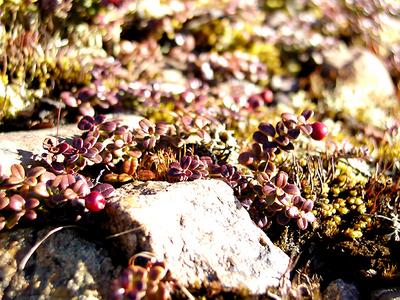
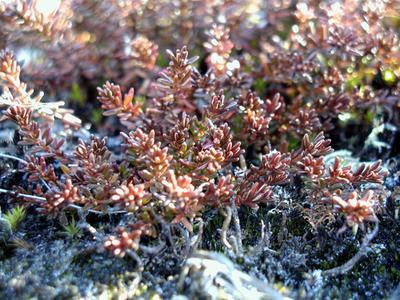
This photo and the one below show some of the tundra plants found near our collection sites. See if you can identify some of the adaptations these plants have made to the extreme conditions of the Arctic.

Small streams such as this one are also a common site here.
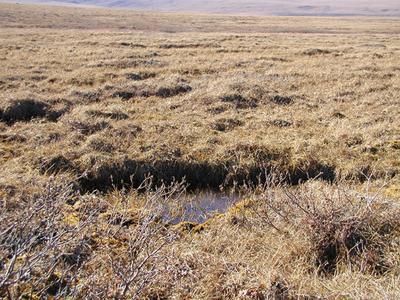
Little pools and potholes like these are found all over the tundra.
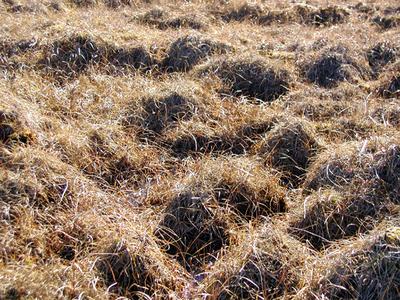
These little lumps in the ground are common where there is water just under the surface. The constant freezing and thawing of water expands the soil into these spongy lumps.
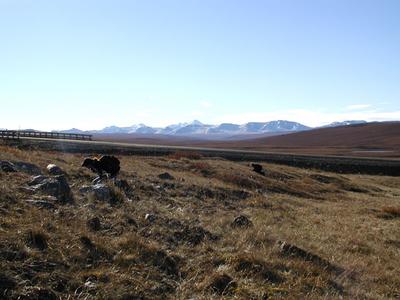
Val Bennett in the foreground and Todd Sformo in the background are scouring this hillside in a search for Carabid Beetles.
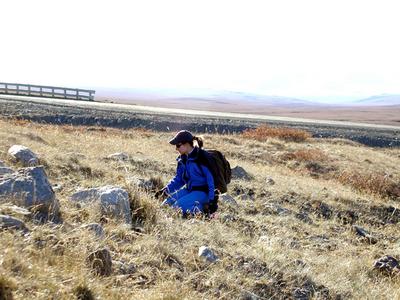
This is Val Bennett looking for Carabid Beetles under rocks along a hillside.
Contact the TEA in the field at
.
If you cannot connect through your browser, copy the
TEA's e-mail address in the "To:" line of
your favorite e-mail package.
|
